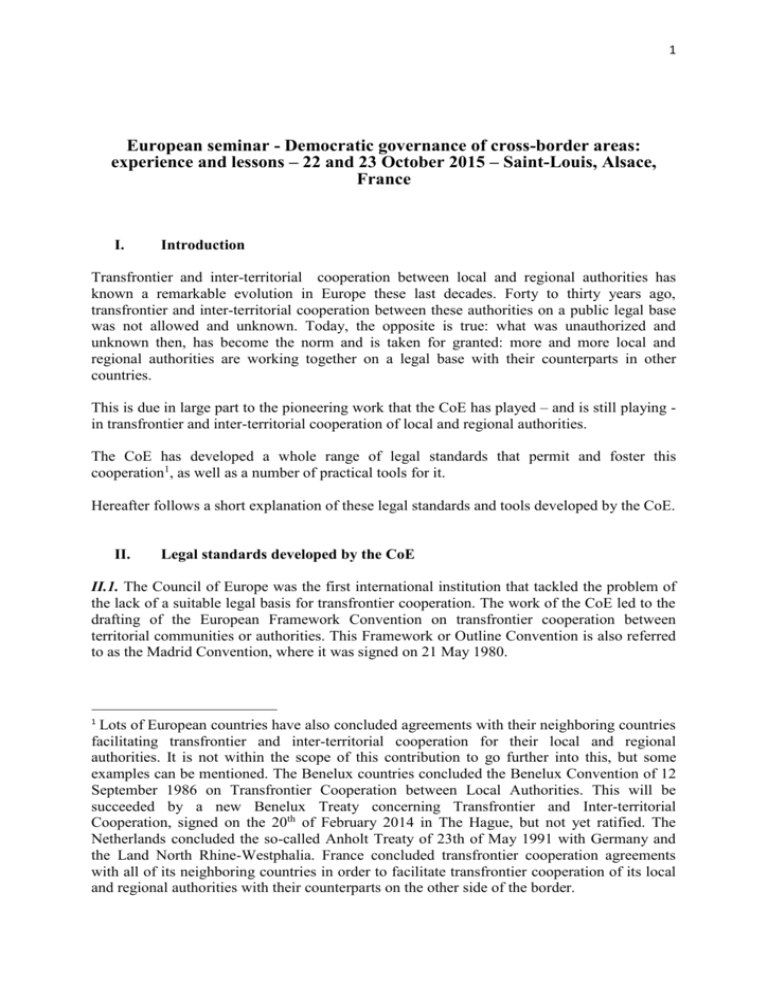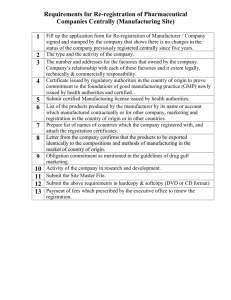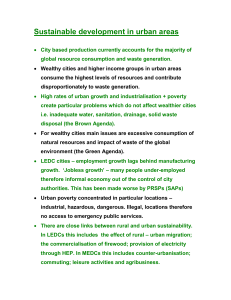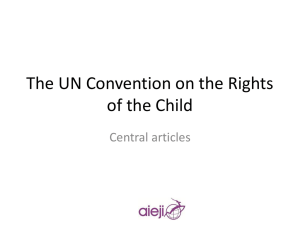22 and 23 October 2015 – Saint
advertisement

1 European seminar - Democratic governance of cross-border areas: experience and lessons – 22 and 23 October 2015 – Saint-Louis, Alsace, France I. Introduction Transfrontier and inter-territorial cooperation between local and regional authorities has known a remarkable evolution in Europe these last decades. Forty to thirty years ago, transfrontier and inter-territorial cooperation between these authorities on a public legal base was not allowed and unknown. Today, the opposite is true: what was unauthorized and unknown then, has become the norm and is taken for granted: more and more local and regional authorities are working together on a legal base with their counterparts in other countries. This is due in large part to the pioneering work that the CoE has played – and is still playing in transfrontier and inter-territorial cooperation of local and regional authorities. The CoE has developed a whole range of legal standards that permit and foster this cooperation1, as well as a number of practical tools for it. Hereafter follows a short explanation of these legal standards and tools developed by the CoE. II. Legal standards developed by the CoE II.1. The Council of Europe was the first international institution that tackled the problem of the lack of a suitable legal basis for transfrontier cooperation. The work of the CoE led to the drafting of the European Framework Convention on transfrontier cooperation between territorial communities or authorities. This Framework or Outline Convention is also referred to as the Madrid Convention, where it was signed on 21 May 1980. 1 Lots of European countries have also concluded agreements with their neighboring countries facilitating transfrontier and inter-territorial cooperation for their local and regional authorities. It is not within the scope of this contribution to go further into this, but some examples can be mentioned. The Benelux countries concluded the Benelux Convention of 12 September 1986 on Transfrontier Cooperation between Local Authorities. This will be succeeded by a new Benelux Treaty concerning Transfrontier and Inter-territorial Cooperation, signed on the 20th of February 2014 in The Hague, but not yet ratified. The Netherlands concluded the so-called Anholt Treaty of 23th of May 1991 with Germany and the Land North Rhine-Westphalia. France concluded transfrontier cooperation agreements with all of its neighboring countries in order to facilitate transfrontier cooperation of its local and regional authorities with their counterparts on the other side of the border. 2 All the Member States of the Council of Europe – except Andorra, Estonia, Greece, Iceland, Malta, San Marino, Serbia, the Former Yugoslav Republic of Macedonia and the United Kingdom – have ratified the Madrid Convention. The Framework Convention creates no rights or obligations for local and regional authorities, but focuses exclusively on the Member States. The Member States which have ratified this Convention are required to make efforts to facilitate and to promote transfrontier cooperation between local and regional authorities on both sides of the border, within the scope of their respective powers. The Member States should for that purpose conclude agreements with their neighboring countries which allows their local and regional authorities to cooperate with each other. Examples of those agreements are attached to the Framework Convention. Such agreements may cover regional development, environmental protection, the improvement of public services, etc., and may include the setting up of transfrontier associations or consortia of local authorities. Important results were achieved on the basis of this Outline Convention – so is for instance the before mentioned Benelux Convention on Transfrontier Cooperation based on this Outline Convention - but there remained, however, some major obstacles, in particular of a legal nature. II.2. Therefore, an Additional Protocol No. 1 to the Outline Convention was concluded on the 9th of November 1995, which has been ratified by 24 of the Member States of the Council of Europe. The Protocol aims to strengthen the Framework Convention by expressly recognizing, under certain conditions, the right of local and regional authorities to conclude transfrontier cooperation agreements, the validity in domestic law of the acts and decisions made in the framework of a transfrontier co-operation agreement, and the legal corporate capacity ("legal personality") of any co-operation body set up under such an agreement. II.3. Local and regional authorities not only work more and more with adjacent authorities on the other side of the border, but also more and more with non-adjacent authorities in other countries2. In order to anticipate this, the CoE drafted an Additional Protocol No. 2, which was opened for signature on the 5th of May 1998. 2 Transfrontier cooperation is generally defined as cooperation between adjacent local and regional authorities of different countries. Inter-territorial cooperation is generally defined as cooperation between non- adjacent local and regional authorities of different countries. This distinction has faded away in practice. An EGC and an EGTC can be used for transfrontier and for inter- territorial cooperation. The before mentioned Benelux Treaties do not made a distinction between transfrontier and inter-territorial cooperation. 3 This Additional Protocol is ratified by 23 member States of the Council of Europe and makes the Framework Convention and the Additional Protocol No. 1 mutatis mutandis applicable on inter-territorial cooperation of local and regional authorities. II.4. An Additional Protocol No. 3 was opened for signature on the 16th of November 2009 and has been ratified by six Member States. This Additional Protocol provides for the legal status, establishment and operation of “Euroregional Cooperation Groupings (ECG)”. Legal personality and aim. The ECG is a legal person, governed by the law of the Member State in which it has its headquarters. The aim of an ECG is for transfrontier and interterritorial co-operation to be put into practice for its members, within the scope of their competences and prerogatives. Membership. Local and regional authorities, as well as the Member States themselves3 and – under certain conditions - all legal persons established for the specific purpose of meeting needs in the general interest, not having an industrial or commercial character. Individuals may not be members of an ECG. Establishment. The partners of an ECG shall, as appropriate, inform, notify or obtain authorization from their national authorities regarding the establishment of such a grouping. Authorization may be refused if membership of the ECG would violate this Additional Protocol or provisions of national law, including the powers and responsibilities of prospective members, or if membership is not justified for reasons of public interest or of public policy of the Member State concerned. Tasks. The ECG performs the tasks which its members entrust it with. There is a great flexibility on the reasons why an ECG can be founded. It can be given all types of functions, from sharing information, through the harmonization or coordination of positions, to the actual implementation of initiatives and projects. The tasks can also involve the implementation of territorial cooperation programs which the EU finances. These objectives can be pursued without the requirement of the ECG of adopting the statute of an EGTC. Supervision, administrative and judicial review. Decisions and acts of an ECG shall be subject to the same supervision and administrative and judicial review of the legality of acts of local and regional authorities as those required in the State in which the ECG has its headquarters. Where an ECG carries out any activity in contravention of the provisions on public policy, public security, public health, public morality or the public interest of the Member States to which its members belong, the competent authority or body of these States may prohibit that activity on its territory or require those members that fall under its jurisdiction to withdraw Central authorities didn’t originally participate with their local and regional authorities in transfrontier cooperation bodies. The agreements didn’t originally mention central authorities as partners in transfrontier cooperation bodies. This changed with the Third Protocol and the EGTC Regulation of 5 July 2006 (see hereafter), which specifically includes central authorities as possible partners of an ECG and EGTC respectively. 3 4 from the ECG unless the latter ceases the activity in question. Review of the competent authority’s or body’s decision by a judicial authority shall be possible. The Third Additional Protocol contains also provisions for the duration, liabilities, dispute settlement and the financial audit of an ECG. In order to facilitate the implementation of this Third Protocol, an appendix has been drafted, which provides more detailed, but optional provisions for the establishment and operation of ECGs. Parties wishing to introduce into their national law all or part of the provisions of this appendix may do so in accordance with the relevant constitutional and legislative procedures. The Committee of Ministers of the CoE has approved this appendix. The CoE has not only drafted legal standards for transfrontier and inter-territorial cooperation, but has also developed much appreciated practical tools. III. Tools developed by the CoE III.1. Centre of Expertise for Local Government Reform – Cross-Border Cooperation Toolkit The Centre of Expertise for Local Government Reform of the Council of Europe has prepared a Cross-Border Cooperation Toolkit, in cooperation with two experts, Daniele Del Bianco, and John Jackson. The Toolkit is an essential and complete guide to cross-border cooperation. It serves as a stepby-step guide on how to turn cross-border projects mapped out on paper into concrete realities. In so doing, it looks at how to carry out feasibility studies, how to finance crossborder projects, what types of obstacles may arise and how these can be overcome, and how to nurture a cross-border friendly environment. The Toolkit contains also case studies. Whether the plan is to organize a jointly run bus route or simply to foster exchanges between civil servants, the toolkit gives a very clear picture of the way ahead. III.2. SWOT Reports on Transfrontier Cooperation Four SWOT Reports, analyzing the Strenghts, Weaknesses, Opportunities and Threats to Transfrontier Cooperation have been published by the CoE: SWOT 1 - Central Europe; SWOT 2 – Northern Europe; SWOT 3 – Comprehensive Overview; SWOT – Strategies and Euroregions for cross-border co-operation in Balkan and Danube European countries III.3. Manual on removing cross border cooperation obstacles This Manual is a compilation of both difficulties recorded across the frontiers and solutions found to overcome them. With the help of ISIG (Istituto di Sociologia Internazionale di 5 Gorizia, Italy), the data collected through a questionnaire have been systematized and organized in such a way as to enable all actors of cross-border cooperation to find examples that correspond to their situation and solutions that may help them to adopt the response to their needs. The Manual is to be maintained on an electronic platform that will be constantly updated with new data and experience. III.4. EDEN Database EDEN is an online database for cross-border cooperation designed by the before mentioned ISIG and sponsored by the CoE. It can be reached on the following web site: http://cbc.isig.it/. Based on best practices, EDEN has the dual objective to gather information on cross-border cooperation and to facilitate networking. The best practices are gathered in EDEN under four sections, namely areas, issues, obstacles and solutions: Areas: contains – by specific areas of cross-border cooperation like Labour Market, Health-Care, Education and Training, etc. - the activities implemented by the users as well as the obstacles they encountered and the solutions they found; Issues: contains the cross-border cooperation activities that the users implemented; Obstacles: contains - by area and by the factors - the obstacles that have been encountered in the implementation of cross-border cooperation activities. Solutions: contains – by area - all the solutions to the obstacle retained by the users. EDEN is expanded and updated. Thank you for your attention! edwin.lefebre@kb.vlaanderen.be







